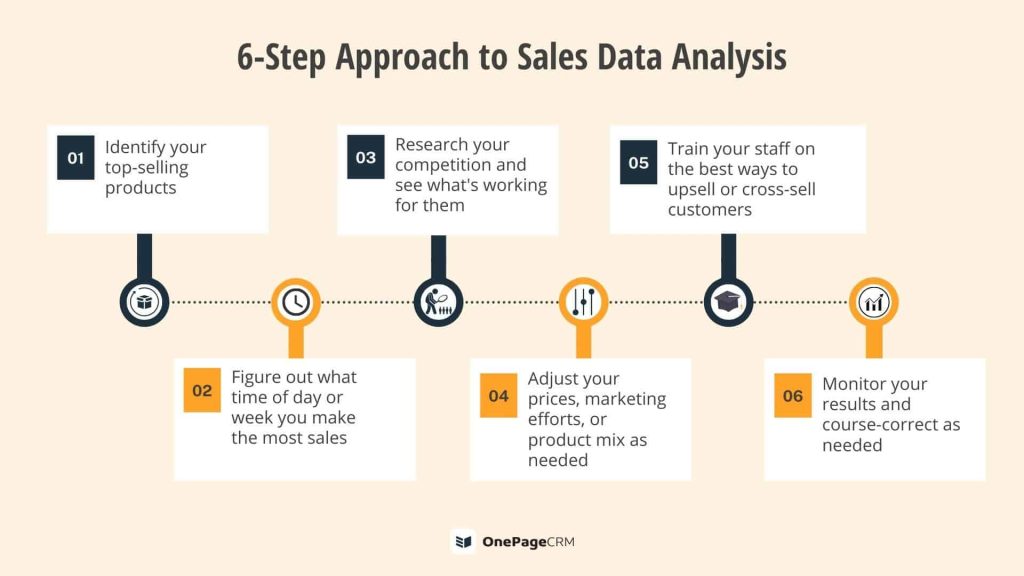
How to increase sales in a small business [10 simple ways]

With competition increasing and consumers becoming more discerning, it’s more critical than ever for small businesses to focus on sales techniques that will set them apart from the pack and help them grow their sales.
In this article, we’ll look at ten ways how small businesses can increase sales.
10 ways to increase sales in small business
- Find out who your ideal customer is
- Put this customer research into action
- Lay a fertile ground for word-of-mouth
- Create a simple sales process
- Automate some processes
- Analyze data
- Incentivize your team
- Review your offerings
- Double-down on customer experience
- Build a market reputation
Let’s take a closer look at how each step can help you grow sales in your business.
1. Find out who your ideal customer is
Understand your current customers, their behavior, and motivation. Why do they choose you over your competitors? What do they have in common?
If there’s a big demand for the type of products or services you provide, it can be hard to narrow down your target market. But everyone can’t be your customer. So try to find the hottest segment and go after it. Once you establish your market presence there, you can expand further. Growth, also in sales, is a gradual process that takes time.
Defining your target market and understanding their needs is one of the most important steps you can take to increase sales. You need to revisit it regularly to ensure you’re still on track.
One way to get to know your customers is to create customer profiles or the so-called buyer personas. This involves identifying their demographics (such as age, gender, location, etc.), as well as their interests, pain points, and what they would like to see from your business.
You can collect feedback through surveys, interviews, or casual conversations. Stay open and listen so you can adjust your processes and strategy accordingly.
2. Target your ideal customers
Finding your ideal customers is only the first step.
Once you understand who your target market is and what they want, you need to start catering to your customers’ needs. This might involve creating new products or services, revamping your marketing strategy, or even slightly changing your website.
For example, if you know that your target market is interested in environmentally-friendly products, you might switch to using recycled materials or investing in green packaging.
Alternatively, if you know that they prefer convenience, you might offer online ordering or home delivery.
3. Lay fertile ground for word-of-mouth
Increasing sales is not just about getting new clients. It’s also about finding ways to not only satisfy your existing clients but motivate them to recommend you to their network.
The majority of small businesses get their sales through referrals so don’t underestimate what this channel can do for you.
Here are a few examples of how you can build the foundation for word-of-mouth:
- Offer a money-back guarantee
- Provide transparent product/service descriptions
- Offer free shipping
- Give discounts, free samples, or running promotions
- Introduce a referral program
There are different ways you can incentivize your existing customers and show them your appreciation to not only do business with you but also to return to you and recommend you to others.
4. Implement a sales process
A sales process can be defined as a set of steps to follow. The process should be well-defined and easy to understand.
The implementation usually starts with training and educating your staff and bringing order to your existing sales processes.
There are several things to keep in mind for creating an efficient sales process that can actually help you increase sales:
- Introduce a follow-up routine to make sure that your sales team is in constant touch with potential customers.
- Make it easy for potential customers to buy from you. Offer multiple payment options, discounts, coupons, free shipping, etc.
- Let your leads learn more about your product. Create content and provide support for different sales stages.
Having a structured process will help increase sales and get happier customers.
5. Automate some processes
When it comes to sales, automation can refer to anything from using a customer relationship management system (CRM) to setting up automatic payments for your invoices.
For example, in OnePageCRM, you can build several simple automation workflows to speed up your work and focus on increasing sales:
- If a sales deal is won, automatically update the associated contact’s status from Lead to Customer.
- Each time your team member creates a new contact, show them a reminder. For example, “Don’t forget to add an industry”.
- When you add or remove a specific tag from a contact, automatically add a note to this contact.
- When a sales cycle is closed, send an automated thank you email to your customer.
And many other ways!
6. Analyze data
According to the latest small business survey, 63% of respondents want to improve their skills in data analysis.
If you’re not analyzing your sales data, you’re missing out on a valuable opportunity to improve your business.
Here’s a step-by-step framework for those wanting to harness sales data analysis.

Step 1: Identify your top-selling products
Knowing which products are selling the best is essential for any business, large or small.
There are a few different ways to identify your top-selling products:
- Look at your sales data over time. At a very basic level, this can even be done using a spreadsheet program like Microsoft Excel or Google Sheets. Create a column for each product and track sales over time. You can then use this data to identify patterns and trends.
- Use a point of sale (POS) system. If you have a POS system in place, you can use it to track which products are selling the most. This information can be valuable in helping you make decisions about what to stock and how to price items.
- Talk to your customers. This may seem like an obvious one, but it’s often overlooked. Simply asking customers what they like and don’t like can give you valuable insights into which products are selling well and which aren’t.
Step 2: Figure out what time of day or week you make the most sales
Knowing when you make the most sales can help you adjust your process accordingly.
For example, suppose you find that you make the majority of your sales on weekends. In that case, you may consider hiring additional staff or running promotions geared explicitly toward those days.
Step 3: Research your competition and see what they’re doing that’s working
When researching your competition, pay attention to their marketing efforts, pricing, and product mix. See what they’re doing that’s working and try to replicate it in your own business.
Of course, don’t forget to put your spin on things so that you stand out from the crowd.
Step 4: Adjust your prices, marketing efforts, or product mix as needed
Once you have a good handle on your sales data, it’s time to start changing your business accordingly.
Remember, the goal is to make changes that will increase sales and boost profits. So, don’t be afraid to experiment until you find what works best for your business.
Step 5: Train your staff on the best ways to upsell or cross-sell customers
Make sure your employees understand the importance of upselling and cross-selling while also giving them the tools they need to succeed.
This may involve providing them with call scripts or specific product recommendations.
Step 6: Monitor your results and course-correct as needed
If you find that your efforts are not yielding the desired results, don’t be afraid to adjust your strategy. The goal is to find what works best for your business and stick with it.
7. Incentivize your team
While focusing on hiring salespeople with the right skills is important, providing incentives for meeting and exceeding sales goals is also essential:
- Understand what motivates your sales team. Some people may be driven by money, while others may respond better to recognition or other non-monetary rewards (such as company swag).
- Set achievable goals for your sales team. Make sure these goals are specific, measurable, attainable, relevant, and time-bound (SMART). Achievable goals have to have a quantity associated with them, for example:
- increasing sales by 10% within the next month
- selling X number of products within a week.
- providing X number of quotes within 24 hours
- giving X number of presentations within a week
- closing X number of deals within the next month
- Provide regular feedback to help your sales team improve. By offering constructive feedback, you can help them identify areas of improvement and work on strengthening their skills.
- Recognize and reward good work. Whatever you do, make sure it’s something that will meaningfully motivate and encourage your team.
- Encourage your sales team to learn new skills. Investing in your team’s development can help them stay ahead of the curve and continue achieving success.
8. Review your offerings
Does your pricing model work for you?
It’s not just about increasing prices (although this might be relevant too to adjust for inflation).
Have a look at whether it makes sense to bundle some of your services or products and offer them together. If you regularly review your services and products, you might find ways to improve.
For example, there might be something that is not working or you might be offering services that no longer have much demand. Maybe it’s time to revisit your product/service catalog.
9. Double-down on customer experience
Running a business is not only about making a profit, it is about providing an excellent experience to your customers. Make sure that they feel heard. After all, the majority of sales comes from repeat business so acquiring new clients is not the only way to increase your sales.
10. Build a market reputation
Building a market reputation can mean one thing to a local business and another thing to a solopreneur. As a solo trader, you’ll need to focus on both: your business reputation as well as your personal brand.
Create relevant content and attend conferences and networking events—find different ways to get in front of your potential customers. This way, you’ll create some familiarity and will be on their mind when they’re ready to buy.
Practical example: how these steps can increase sales
The above points are just theory—and theory without application is not very useful for growing sales. So here’s an example of how the above steps can be helpful to your small business.
Say you run a coffee shop and want to increase sales of pastries, as these are your top-selling products. The next step would be to figure out when you’re selling the most pastries. This information will help your staff accordingly and ensure you have enough product during your busiest periods.
Then, take a look at your competition. Are they selling similar items? If so, how are they marketing them? What prices are they charging? This research can give you ideas for adjusting your prices, marketing efforts, or product mix.
Finally, train your staff on the best ways to upsell or cross-sell customers. For example, if someone orders a coffee, let them know about your delicious pastries and offer to bag one up for them. Or, if someone seems undecided on what to order, suggest pairing a pastry with their coffee.
Monitor your results regularly and course-correct as needed. If you do not see the desired results, try tweaking your approach and see what happens. If your pastries are selling well, but you’re not seeing an uptick in coffee sales, then focus your efforts on marketing and promoting your coffee.
Following these simple steps can increase your small business sales and allow you to reach your goals.
Growing sales is important for any small business
A company that can’t make sales will soon go out of business.
Having a system to increase sales is essential for any business, especially small ones.
Implementing a sales process, cultivating customer relationships, automating your sales process, and analyzing your sales data are all effective ways to increase sales. Incentivizing your sales team and focusing on your customers’ needs are also important.
By following these tips, you can increase sales and help your small business succeed both now and in the future.










